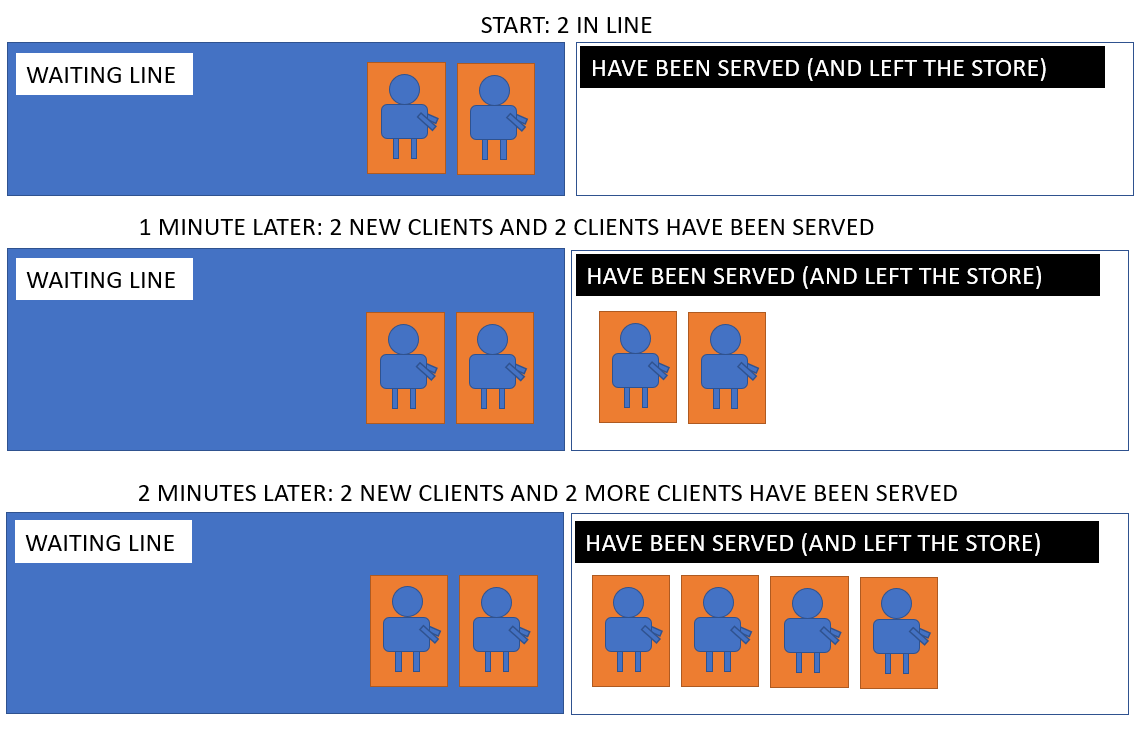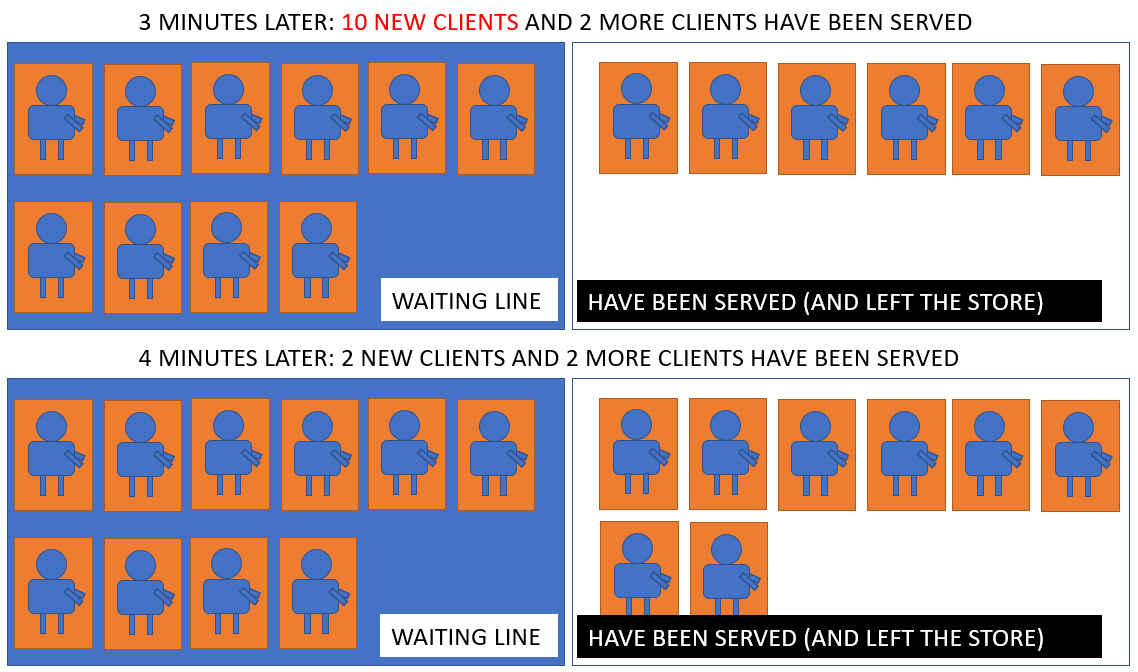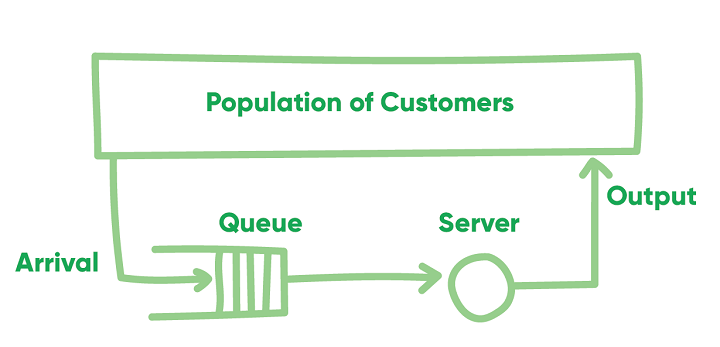Explain Briefly Different Types of Queuing Models
There are four types of Queue. Data Plane 5 The Network Layer.

Waiting Line Models A Full Guide To Waiting Line Models And By Joos Korstanje Towards Data Science
Models can be classified on the basis of following factors.

. Service in random order SIRO. Normative models for repetitive problems. An MMc queue Multiple servers on 1 waiting line.
Give and explain briefly that in what kinds of situations is queuing analysis is most appropriate. Typical measures of system performance Server utilization length of waiting lines and delays of. Poisson distribution for the number of arrivals per time frame.
In the class we discussed different types of queuing models used by companiesservice systems to manage the waiting lines of customers and waiting time that customers spend in queues to get services at service systems. Notice that a FIFO queue discipline implies that services begin in the same order as arrivals but that customers could leave the system in a different order because of different length service times. Want to see the full answer.
Symbolic or mathematical models. Define queueing system and briefly explain the major factorscharacteristics that needs to be considered. In the class we discussed different types of queuing models used by companiesservice systems to manage the waiting lines of customers and waiting time that customers spend in queues to get services at service systems.
Common queue disciplines include first-in-first-out FIFO last-in-first-out LIFO service in random order SIRO etc. Based on your understanding Define queueing system and briefly explain the major factorscharacteristics that needs to be. Purpose Simulation is often used in the analysis of queueing models.
Multiple processes can read and write data to the message queue without being connected to each other. When equilibrium is reached in a queueing system with Poisson. The number X t of customers in the system at time t forms a birth and death process.
It is also called Ring Buffer. Each of the inventory management models has an alternate way to deal with assisting you to know how much stock you ought to have available. Though queueing analysis has been used in hospitals and other healthcare settings its use in this.
It is also called a lightweight process. IV By Nature of Environment. This queue is primarily used in.
A queuing system is called a one-server model ie when the system has only one server and a multi-server model ie when the system has a number of parallel channels each with one server. Messages are stored on the queue until their recipient retrieves them. MMc queue Multiple servers on 1 Waiting Line.
There are five different types of queues which are used in different scenarios. Thread is a sequence of instructions within a process. I By degree of Abstraction.
And service according to priority PR. A priority queue is a special type of queue in which each element is associated with a priority and is served according to its priority. The different inventory management models Three of the most popular inventory management models are Economic Order Quantity EOQ Inventory Production Quantity and ABC Analysis.
Shortest processing time first SPT. Simple Queue Simple queue defines the simple operation of queue in which insertion occurs at the rear of the list and deletion occurs at the front of the list. A Arrangement of service facilities in series 1 Single Queue Single Server 2.
Message Passing Model. A thread is the basic unit of CPU utilization. The MM1 queue Arrivals follow a Poisson process.
Message queues are quite useful for interprocess communication and are used by most operating systems. Again Poisson arrivals see time averages. Computer Networks And The Internet.
Dequeue Double Ended Queue 1. A thread behaves like a process within a process but it does not have its own PCB. 1 Computer Networks And The Internet 2 Application Layer 3 Transport Layer 4 The Network Layer.
For a queueing system in steady state with Poisson arrivals we have the following properties. 1 The probability a n of the number n found by an arriving customer is equal to the probability d n of the number n left behind by a departing customer. DM1 queue Fixed arrival intervals Markovian service and 1 server.
Queue discipline refers to the rule that a server uses to choose the next customer from the queue when the server completes the service of the current customer. Insertion occurs based on the arrival of the values and removal occurs based on. Define queueing system and briefly explain the major factorscharacteristics that needs to be considered for designing a.
Give and explain briefly that in what kinds of situations is queuing analysis is most appropriate. And there is a single server. Control Plane 6 The Link Layer And Lans 7 Wireless And Mobile Networks 8 Security In Computer Networks 9 Multimedia Networking expand_more.
Service times are exponentially distributed. A simple but typical queueing model Waiting line Server Calling population Queueing models provide the analyst with a powerful tool for designing and evaluating the performance of queueing systems. Circular Queue is a linear data structure in which the operations are performed based on FIFO First In First Out principle and the last position is connected back to the first position to make a circle.
See Section 92 The MM queue There are Poisson arrivals and exponentially distributed service times. If elements with the same priority occur they are served according to their order in the queue. Queueing models to help manage and allocate resources in order to respond to demands in a timely and cost-efficient fashion.
Advantage of Messaging Passing Model. MDc queue Markovian arrival Fixed service times multiple servers. An MMc queue is characterized by.
Service from different types of servers in a sequential manner. For example a surgical inpatient requires an. Threads Multithreading Types of thread Multithreading models in Operating Systems OS Thread in Operating system.
Any number of customers are processed. Common queue disciplines include first-in-first-out FIFO. In the class we discussed different types of queuing models used by companiesservice systems to manage the waiting lines of customers and waiting time that customers spend in queues to get services at service systems.

Queuing Theory Definition History Real Life Applications

Waiting Line Models A Full Guide To Waiting Line Models And By Joos Korstanje Towards Data Science

Event Management System Er Diagram Event Management System Event Management Data Modeling

Comments
Post a Comment